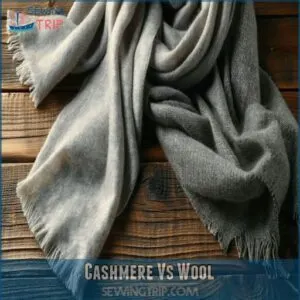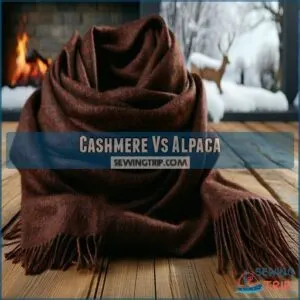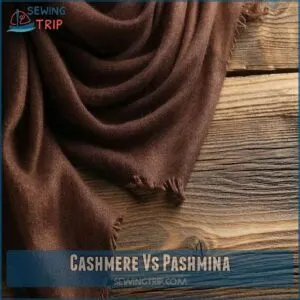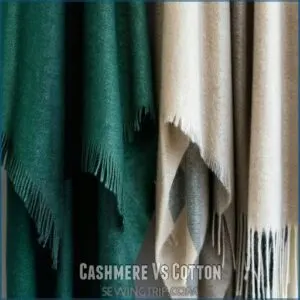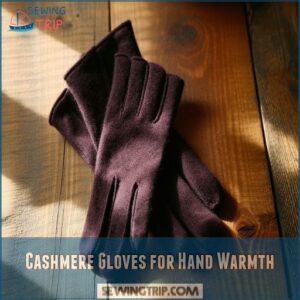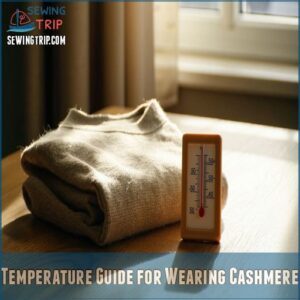This site is supported by our readers. We may earn a commission, at no cost to you, if you purchase through links.

With an excellent warmth-to-weight ratio, it’s like having a personal heater that’s oh-so-soft.
Imagine wearing a cloud that keeps you cozy while letting you feel as light as a feather.
Unlike other fibers, cashmere’s fine strands trap heat more efficiently, providing insulation that rivals your best cup of hot chocolate.
Plus, it’s gentle on your skin, making you feel snug and sophisticated.
Ready to transform those chilly winter days into a stylish embrace?
Dive deeper into how cashmere ticks all the right boxes this season.
Table Of Contents
- Key Takeaways
- Benefits of Cashmere for Winter
- Is Cashmere Warm for Winter?
- Cashmere Vs Other Materials
- Factors Affecting Cashmere’s Warmth
- Choosing The Right Cashmere for Winter
- Temperature Guide for Wearing Cashmere
- Caring for Your Cashmere in Winter
- Benefits of Wearing Cashmere at The Right Temperature
- Cashmere’s Durability and Longevity
- Why Cashmere is Ideal for Winter
- Frequently Asked Questions (FAQs)
- Conclusion
Key Takeaways
- You’ll find cashmere provides exceptional warmth with its fine fibers that trap heat efficiently, making it up to eight times warmer than regular wool.
- Cashmere maintains a high warmth-to-weight ratio, offering luxurious insulation without the bulk, perfect for winter layering.
- Proper care, including hand washing and flat drying, prolongs cashmere’s lifespan while ensuring it retains its softness and insulation properties.
- When compared to other materials, cashmere’s versatility and elegant styling make it an ideal choice for winter wear, providing comfort and style in one package.
Benefits of Cashmere for Winter
You’ll love how cashmere’s ultra-fine fibers trap eight times more warmth than regular wool while keeping you cozy without the bulk.
When you’re bundled up in this luxury fiber during winter, you’re getting nature’s best insulation that adapts to your body temperature, making it worth every penny of its premium price tag.
Cashmere’s Natural Insulation Properties
Every cashmere fiber contains microscopic air pockets that work like your home’s insulation system.
These natural properties make cashmere an exceptional choice for winter warmth.
Here’s how cashmere keeps you cozy:
- Creates thermal barriers that trap body heat
- Forms countless tiny air chambers within the fiber structure
- Adapts to your body temperature like a smart thermostat
- Maintains consistent warmth even in varying temperatures
Fine Fibers for Lightweight Warmth
Like tiny threads of cloud-soft comfort, cashmere’s ultra-fine fibers create an incredible insulating layer that keeps you cozy without weighing you down, much like how wool vs fleece difference highlights wool’s ability to retain warmth when wet.
Each fiber measures just 14-16 microns in diameter – that’s about six times finer than human hair.
This remarkable fineness allows cashmere garments to trap more warm air while remaining lightweight and breathable, making them perfect for those chilly winter days.
High Warmth-to-Weight Ratio
Beyond its fine fibers, cashmere’s remarkable warmth-to-weight ratio makes it a winter winner.
You’ll get maximum warmth without feeling weighed down, which is perfect for layering or traveling light.
Here’s why cashmere’s warmth-to-weight ratio stands out:
- Packs down smaller than traditional wool sweaters
- Weighs about half as much as regular wool
- Provides 8x more warmth than regular wool
- Maintains insulation even when compressed in luggage
Comfort and Style in One
Cashmere’s exceptional warmth doesn’t mean you’ll have to sacrifice style.
You’ll find yourself reaching for cashmere pieces that work seamlessly from morning coffee runs to evening dinner parties.
Its versatile nature lets you dress it up or down – pair a classic cashmere sweater with jeans for everyday comfort, or layer it under a blazer for special occasions.
The fabric’s natural drape creates an effortlessly polished look that’s always in style.
Is Cashmere Warm for Winter?
For winter warmth, cashmere stands out as a true champion.
You’ll find this luxury fiber packs an impressive warmth rating of 8 out of 10, making it perfect for chilly days.
Its remarkable insulation comes from the unique structure of its fibers, which trap warm air close to your body.
Think of it as nature’s own thermostat – it’ll keep you cozy at temperatures as low as -40°F.
Plus, you won’t feel weighed down since these fine fibers provide exceptional warmth without the bulk.
Cashmere Vs Other Materials
You’ll find that cashmere stands out from other winter fabrics with its impressive warmth rating of 8 out of 10, making it eight times warmer than regular wool.
When you’re choosing between winter materials, you’ll want to compare cashmere against popular alternatives like wool, fleece, alpaca, pashmina, and cotton to find what works best for your needs.
Cashmere Vs Wool
You might wonder how cashmere stacks up against regular wool.
Here’s the real deal: cashmere fibers are actually eight times warmer than sheep’s wool, while being much lighter and softer against your skin.
Think of it like comparing a plush blanket to a scratchy one.
Yes, you’ll pay more for cashmere, but you’re getting unmatched warmth without the bulk or itch factor.
Cashmere Vs Fleece
In contrast to synthetic fleece, high-quality cashmere offers unmatched elegance with superior durability.
While both materials provide warmth, they differ in key ways:
- Cost: Fleece is budget-friendly, while cashmere is a luxury investment
- Durability: Fleece pills easily but resists tears, cashmere lasts decades with proper care
- Comfort: Cashmere feels silkier against skin
- Versatility: Fleece excels in outdoor activities, cashmere shines in both casual and formal settings
Cashmere Vs Alpaca
Comparing these two luxury fibers reveals fascinating differences that might surprise you.
While cashmere offers exceptional softness and warmth, alpaca wool takes the crown for superior heat retention and durability.
Here’s how they stack up:
| Feature | Cashmere | Alpaca |
|---|---|---|
| Warmth Rating | 8/10 | 9/10 |
| Durability | Moderate | High |
| Cost | Premium | Ultra-Premium |
| Weight | Very Light | Light |
Want the absolute warmest option? Alpaca’s your answer, though you’ll pay more for that extra coziness.
Cashmere Vs Pashmina
While both fabrics share luxurious origins, pashmina and cashmere aren’t exactly twins.
Many don’t realize that pashmina is actually a type of cashmere, sourced from Himalayan mountain goats at higher altitudes.
The resulting fibers are finer, measuring 15-18 microns in diameter, similar to traditional cashmere fibers.
However, this delicacy means it’s less suitable for heavy winter wear, though perfect for elegant shawls and scarves.
Cashmere Vs Cotton
Cotton crumbles in the warmth department when stacked against cashmere, scoring just 1 out of 10 on the warmth scale compared to cashmere’s impressive 8.
You’ll need multiple cotton layers to match cashmere’s natural insulation properties.
While cotton’s affordability might tempt you, its limited temperature regulation and moisture-wicking abilities make it less ideal for serious winter wear.
Cashmere offers superior comfort and warmth, despite the higher cost.
Factors Affecting Cashmere’s Warmth
You’ll find that your cashmere’s warmth depends on several key features, from the quality of the fibers to how you care for them.
Whether you’re buying a new cashmere sweater or maintaining your favorite scarf, understanding these factors will help you get the most warmth from your luxury garment.
Ply Count and Its Impact on Warmth
Understanding ply count can make or break your cashmere experience.
Like building a cozy blanket fort, each layer of cashmere adds extra warmth.
Here’s what you need to know about cashmere plies:
- Single-ply feels light as a feather, perfect for mild days
- Two-ply offers double the warmth without bulk
- Three-ply delivers maximum toastiness for frigid weather
- Four-ply provides heavyweight protection
- Multiple plies create a denser, more durable fabric
The Importance of Proper Care
Proper care, including methods like hand wash cashmere in cool water with gentle detergent, directly impacts how warm your cashmere keeps you through winter.
You’ll want to hand wash your pieces in cold water with gentle detergent, or opt for professional dry cleaning to maintain those insulating properties.
Reshape your garments while damp and dry them flat to preserve their structure.
Regular maintenance, like using a cashmere comb for pills, helps your pieces retain their warmth-trapping abilities.
Quality of Cashmere Material
When shopping for cashmere, the quality of the material makes all the difference in how warm you’ll stay.
The best cashmere comes from goats bred in Mongolia and China, where harsh winters create finer, denser fibers.
Look for grade A cashmere with longer fibers and minimal pilling. You’ll notice superior warmth from these high-quality pieces, which typically have a softer feel and better pilling resistance.
Layering for Enhanced Warmth
Layering your cashmere strategically can transform a simple sweater into a cozy winter fortress.
Start with a lightweight silk or cotton base layer to create a moisture-wicking foundation.
Add your cashmere piece as the middle layer for insulation, then top it off with a weather-appropriate outer layer.
This three-layer system traps warm air between each layer, maximizing your cashmere’s natural warming properties.
Choosing The Right Cashmere for Winter
You’ll find the perfect cashmere piece for winter when you know what to look for in gloves, socks, coats, and sweaters.
Whether you’re battling freezing temperatures or just need a cozy layer, choosing the right cashmere item will keep you warm without weighing you down.
Cashmere Gloves for Hand Warmth
Cashmere gloves offer the perfect blend of luxury and practicality for your winter needs.
You’ll find they’re remarkably soft against your skin while creating an effective barrier against harsh temperatures.
Unlike bulky alternatives, they’re slim enough to fit in your coat pockets yet warm enough to keep your hands cozy.
While they’re pricier than fleece options, their superior insulation and elegant look make them worth considering.
Cashmere Socks for Foot Warmth
Your feet deserve the royal treatment after keeping those cashmere gloves in mint condition.
Stepping into cashmere socks is like wrapping your feet in clouds of warmth.
These luxurious foot-huggers offer:
- Superior moisture-wicking that keeps toes dry even during long winter walks
- Natural temperature regulation that works in boots or slippers
- Incredible softness that makes every step feel like you’re walking on air
They’re perfect for cozy nights in or adding an extra layer of warmth during winter activities.
Cashmere Coats for Outerwear
When winter’s chill sets in, a well-made cashmere coat becomes your best friend.
Like wrapping yourself in a cloud, these luxurious coats provide remarkable warmth without the bulk of traditional winter wear.
Cashmere coats are certainly an investment piece, ranging from $500 to several thousand dollars, but their timeless elegance and exceptional insulation make them worth every penny.
They’ll keep you cozy in temperatures as low as -40°F.
Cashmere Sweaters for Layering
Layer like a pro by treating your cashmere sweater as the star of your winter wardrobe.
After slipping off that cozy coat, you’ll want a sweater that works overtime.
Smart layering keeps you toasty while showing off cashmere’s natural elegance.
Since cashmere is eight times warmer than wool and has excellent temperature regulating properties, it makes a perfect base for winter outfits.
- Pair a thin cotton undershirt with a v-neck cashmere sweater for office-ready style
- Mix textures by layering a silk camisole under a crew neck for extra warmth
- Add a fitted tank top beneath chunky knits to trap heat without bulk
Temperature Guide for Wearing Cashmere
You’ll get the most out of your cashmere when you know the right temperatures to wear it, from cozy sweaters below 50°F to lightweight wraps up to 75°F.
While you can technically wear cashmere year-round, you’ll feel most comfortable choosing the right pieces for each temperature range to avoid either shivering or sweating in your luxury garments.
Cold Weather (50°F and Below)
Now that you’ve chosen your cashmere pieces, let’s master cold-weather styling.
Temperatures below 50°F call for strategic cashmere layering that maximizes warmth without bulk.
| Temperature | Recommended Layering | Best Cashmere Pieces |
|---|---|---|
| 30-50°F | Light base + cashmere | Sweater or cardigan |
| 20-30°F | Thermal + cashmere | Turtleneck or coat |
| 10-20°F | Base + wool + cashmere | Heavy coat or wrap |
| Below 10°F | Multiple layers + cashmere | Double-layer pieces |
Think of cashmere as your cold-weather superhero – it’s like wearing a warm hug that keeps you cozy without the bulky, marshmallow look.
Cool Weather (50°F to 65°F)
Cool spring mornings and crisp fall days call for lightweight cashmere layers.
You’ll find that single-ply cashmere sweaters and wraps hit the sweet spot between 50°F and 65°F.
A thin cashmere cardigan works perfectly over a silk blouse for the office, while a classic V-neck sweater pairs beautifully with jeans for weekend errands.
These versatile pieces keep you cozy without overheating.
Mild Weather (65°F to 75°F)
During mild spring and fall days, cashmere shawls and lightweight sweaters become your perfect companions. You’ll find cashmere adapts beautifully to temperatures between 65°F and 75°F, offering just the right balance of comfort and style.
If you’re looking to elevate your wardrobe with a versatile accessory, consider shopping for a cashmere scarf online.
- Drape a cashmere shawl over your shoulders for evening changes
- Choose single-ply pieces for better breathability
- Opt for loose-fitting styles that allow air circulation
- Roll up sleeves or push them up when needed
Warm Weather (Above 75°F)
Three key rules apply when temperatures soar above 75°F: you’ll want to skip the cashmere.
Here’s why it’s not your best friend in warm weather, plus some smart alternatives:
| Temperature | Cashmere Risk | Better Choice | Comfort Level | Style Tip |
|---|---|---|---|---|
| 75-80°F | High | Cotton blend | Moderate | Light layers |
| 80-85°F | Very high | Linen | Low | Loose fits |
| 85-90°F | Extreme | Bamboo fabric | Very low | Breathable cuts |
| 90-95°F | Not recommended | Technical fabrics | Poor | Moisture-wicking |
| 95°F+ | Avoid completely | Performance wear | Unsuitable | Cooling designs |
Caring for Your Cashmere in Winter
You’ll need to give your cashmere sweaters and accessories some extra TLC during the winter months to keep them looking and feeling their best.
Caring for cashmere might seem tricky at first,
you’ll find it’s worth the effort when your favorite pieces stay soft and cozy throughout the cold season.
Washing and Drying Techniques
Maintaining your cashmere’s warmth starts with proper cleaning.
You’ll want to give your luxurious pieces the care they deserve with these proven washing and drying techniques:
- Hand wash in cold water with mild detergent
- Skip the wringing – gently squeeze instead
- Roll in a clean towel to remove excess water
- Reshape while damp to maintain fit
- Dry flat away from direct heat or sunlight
Remember, gentle treatment keeps your cashmere cozy and looking its best season after season.
Storing Cashmere in Winter
Store your precious cashmere pieces like you’d protect a treasure – in a cool, dry place away from direct sunlight.
Cedar blocks or lavender sachets are your best friends here, naturally repelling those pesky moths.
Fold each item gently (never hang them!) and place them in breathable cotton storage bags.
Between wears, give your cashmere 24 hours to rest, helping it maintain its shape and luxurious feel.
Removing Pilling and Fuzz
To keep your cashmere looking new, you’ll want to tackle those pesky pills and fuzz.
For more thorough care, consider investing in a high-quality cashmere brush tool.
Here’s how:
- Grab a cashmere comb—gently run it over the fabric to lift away pills.
- Use a fabric shaver for a more thorough cleanup without damaging the fibers.
- Avoid excessive friction when wearing and storing to prevent further pilling.
Professional Cleaning Services
Cashmere dry cleaning is like sending your sweater to a spa day.
Professional cleaning is recommended for cashmere garments that require delicate care, especially those that have been damaged by cashmere fibers pilling. Professional cleaning costs can be higher than hand-washing, but it helps preserve your cashmere’s luxury feel.
When hand-washing, be aware that cashmere shrinks easily and can be unshrunk by soaking in a solution of cold water and hair conditioner for cashmere.
Choose reputable cleaners for peace of mind.
| Pros | Cons |
|---|---|
| Gentle on fabric | Higher costs |
| Eco-friendly options | Less control over process |
| Convenient | Need to find a good cleaner |
Benefits of Wearing Cashmere at The Right Temperature
Wearing cashmere at the right temperature keeps you cozy without overheating; you’ll enjoy its luxurious comfort and extend its lifespan, looking stylish all winter long.
Preventing Overheating
Balancing warmth and comfort when you’re wearing cashmere is key. Too warm? Blame it on thick layers. Here’s how to keep your cool:
- Cashmere Layering: Stick to lightweight options.
- Summer Cashmere: Choose breathable fabrics.
- Cotton Blend: Try a cotton blend for versatility.
- Lightweight Options: Opt for thinner garments in warmer weather.
Stay stylish but prevent overheating.
Maintaining Comfort
Ever slipped on something that felt like a warm hug on a frosty day?
Wearing cashmere at the right temperature does just that—ensuring you’re cozy without causing a sweat.
Check out this quick comfort guide:
| Temperature | Apparel Choice |
|---|---|
| 50°F & Below | Thick cashmere layers |
| 50°F to 65°F | Light cashmere sweaters |
| 65°F to 75°F | Cashmere wraps |
| Above 75°F | Avoid cashmere |
With cashmere layering, your winter wardrobe becomes a cozy sanctuary.
Prolonging Cashmere’s Lifespan
Keep cashmere cozy season after season with smart care.
Start by:
- Washing tips: Use mild detergent and cold water; hand wash or use a gentle cycle.
- Pilling prevention: A cashmere comb keeps fuzz at bay.
- Cashmere storage: Fold, don’t hang. Keep in a cool, dry spot to avoid stretching.
Following these tips will help your cashmere last longer while staying comfy.
Enhancing Style and Elegance
Wearing cashmere at the right temperature can boost your elegance and style, combining coziness with flair.
Wondering how it fits? Here’s a quick guide: For an effortless winter look, complement your outfit with a warm cashmere scarf.
| Accessory | Styling Tip |
|---|---|
| Scarves | Pair with neutral tones |
| Gloves | Opt for classic colors |
| Sweaters | Layer for texture |
These styling tips guarantee your sophistication shines without a hitch.
Cashmere’s Durability and Longevity
You’ve probably heard cashmere is incredibly soft, but did you know it’s also tough when treated right?
With a little TLC and smart care, your cashmere can stay plush and pill-free,
making it a timeless addition to your wardrobe.
Cashmere’s Natural Fibers
Choosing cashmere for your winter wardrobe feels like embracing a warm hug from nature itself.
The secret lies in the cashmere goat breeds and their ultra-soft, fine fibers.
This fiber structure excels at trapping heat, offering unparalleled insulation properties and unmatched softness.
Cashmere’s durability shines, giving you comfort and warmth throughout countless cold seasons, without compromising on style.
Proper Care for Long-Lasting Cashmere
Cashmere’s natural fibers are wonderfully soft, but they need TLC to stay that way.
Proper care is key to enjoying your cashmere for years.
To keep your cashmere looking its best, follow these simple steps:
- Hand-wash or machine-wash gently in cold water with a mild detergent.
- Lay it flat to dry; avoid harsh sunlight.
- Store your cashmere folded in a cool, dry place. Think of it like tucking your favorite sweater into bed for a long winter’s nap.
Avoiding Damage and Pilling
To keep your cashmere looking fresh, remember a few simple cashmere care tips.
To properly care for your cashmere sweaters, gently iron them on the lowest heat setting using a how to iron cashmere technique. Gently hand wash it or use a machine’s delicate cycle, avoiding hot water—it’s like a spa day for your sweaters.
Store them folded, not hung, to prevent stretching.
And, a cashmere comb can be your best friend for tackling those pesky pills.
Cashmere’s Timeless Appeal
While it’s important to keep cashmere in top shape, its timeless appeal doesn’t go out of style.
Imagine wrapping yourself in a luxurious, toasty fabric that’s been adored for centuries.
Cashmere’s durability and the craftsmanship behind each piece make it a worthwhile investment.
This luxury fiber blends history with warmth, offering you unmatched comfort while standing the test of time.
Why Cashmere is Ideal for Winter
When winter rolls around, you want a fabric that feels like a warm hug, and cashmere does that effortlessly with its unparalleled insulation system and cozy softness.
Cashmere‘s ability to wick moisture while being breathable guarantees you stay warm and stylish without overheating, making it the perfect winter companion.
Cashmere’s Unique Insulation System
When you’re wrapped in cashmere, you’re embracing a fabric known for its impressive insulation.
The fibers are like tiny air traps, enhancing warmth without adding bulk. It’s like wrapping yourself in a cozy hug that’s lightweight yet incredibly effective.
You’ll find:
- A luxury warmth-to-weight ratio
- Excellent temperature regulation
- Natural fiber structure maximizing insulation
Cashmere’s Softness and Comfort
While alpaca wool’s hypoallergenic properties are a great alternative for those with sensitive skin, sinking into cashmere’s softness feels like a warm hug from an old friend.
Cashmere comfort isn’t just about warmth; it’s the luxury of being wrapped in a cloud.
Its softness provides unparalleled coziness, making it ideal for winter wear, especially since cashmere, like other types of wool, traps warm air close to the body for efficient insulation.
Picture yourself in that dream material—stylish, snug, and sensational.
| Feature | Benefit | Example |
|---|---|---|
| Soft Feel | Ultimate Comfort | Sweaters |
| Light Weight | Easy Layering | Cardigans |
| Insulation | Efficient Warmth | Coats |
| Versatile | Everyday Use | Scarves |
| Luxurious | High Status | Shawls |
Cashmere’s Breathability and Moisture-Wicking Properties
Cashmere isn’t just about warmth—it’s a comfort powerhouse with breathability benefits.
It’s like a personal climate control system that helps you stay dry and cozy.
Here’s how:
- Moisture Management: Cashmere wicks away sweat.
- Temperature Regulation: Keeps you warm without overheating.
- Fresh Comfort: Keeps you feeling fresh throughout the day.
Cashmere comfort keeps everything just right!
Cashmere’s Luxurious Appeal and Style
Beyond its warmth, cashmere offers undeniable luxury.
Think of it as the velvet of the fiber world – soft, smooth, and incredibly comfortable against your skin.
Its subtle sheen adds a touch of elegance to any outfit, effortlessly elevating your style.
Cashmere’s timeless appeal means it’s a smart investment that transcends fleeting fashion trends, offering enduring sophistication.
You’ll feel pampered and put-together in its luxurious embrace.
Frequently Asked Questions (FAQs)
Is Cashmere warmer than cotton?
You’ll find cashmere much warmer than cotton.
Picture wearing a cozy blanket on a chilly day—that’s cashmere for you.
Its fine fibers trap heat, making it perfect for winter, unlike cotton, which offers much less insulation.
Is Cashmere warm in winter?
Imagine wrapping yourself in a cozy warm hug on a chilly day—that’s what wearing cashmere feels like in winter.
Its fine fibers trap heat efficiently, offering warmth without bulk.
It’s your stylish, lightweight shield against the cold.
Is Cashmere a good material for winter clothing?
Cashmere’s perfect for winter clothing.
Its lightweight but warm fibers act like a cozy shield against the cold, keeping you snug without bulk.
You’ll stay stylish and toasty, even when temperatures plunge.
How to wear cashmere in cold weather?
Escape the winter chill in style! Layer a cashmere sweater under a coat for extra warmth. Cashmere scarves and gloves add cozy comfort. Enjoy the luxurious feel and unbeatable warmth.
Does Cashmere keep you Toasty in the Cold?
Absolutely, cashmere keeps you toasty in the cold!
Its fine fibers trap air, providing superior insulation.
Whether you’re sledding or sipping hot cocoa by the fire, cashmere wraps you in cozy warmth without the bulk.
Is cashmere wool warm?
You bet cashmere wool is warm!
It’s like wearing a cozy hug, thanks to its fine fibers trapping heat without the bulk.
Perfect for winter, it keeps you snug and stylish when temperatures drop.
Can I wear cashmere in winter?
Cashmere is eight times warmer than wool, making it perfect for winter’s chill.
Cashmere is a soft, warm hug.
Slip into a cashmere sweater when it’s freezing outside, and you’ll feel cozy without the bulk, like wrapping yourself in a soft, warm hug.
Is cashmere warmer than fleece?
Fleece can’t compete with cashmere’s exceptional warmth – it’s considered 8 times warmer than wool, making it the ultimate cold-weather champion.
Lightweight yet toasty winter insulation without the bulk.
What’s warmer, merino wool or cashmere?
When winter bites, cashmere keeps you warmer than merino wool, thanks to its fine fibers that trap heat efficiently.
Cashmere wraps you in unmatched softness and warmth, whether you’re strolling in the snow or cozying up inside.
What are the disadvantages of cashmere?
It’s a bit pricey, you know? Plus, it’s delicate; you’ll need to hand-wash it, and those pesky pills can appear. It’s also not the most durable fabric around.
How does cashmere handle moisture and humidity?
Cashmere naturally wicks moisture away from your skin, keeping you comfortable and dry in humid conditions.
Breathable fibers help regulate body temperature, managing humidity like a skilled acrobat balancing warmth and dryness with ease and elegance.
Does layering affect cashmeres warmth?
Layering enhances cashmere’s warmth by trapping more air, boosting insulation like a thermal sandwich.
Cashmere is a warm and stylish choice for winter.
Pair your cashmere sweater with a snug base layer for a cozy, stylish combo that keeps the winter chill at bay.
Are there eco-friendly cashmere options available?
Looking for warmth and a conscience? Eco-friendly cashmere‘s your answer.
Some brands source sustainable cashmere from places like Mongolia, ensuring ethical treatment of goats and protecting pastures.
It’s soft, green, and guilt-free—just the winter vibe you want.
How does cashmere compare to synthetic fibers?
You might find cashmere offers exceptional warmth and softness compared to synthetic fibers, which can feel less cozy.
Synthetic fibers are often durable and affordable.
They lack the natural insulation and luxe feel that cashmere provides.
What ethical concerns surround cashmere production?
Cashmere production raises ethical concerns, including animal welfare, as goats are sometimes mistreated.
Environmental issues arise from land degradation due to overgrazing.
Also, workers often face poor labor conditions, making fair trade practices essential for improvement.
Conclusion
So, is cashmere warm for winter? Absolutely!
Did you know that cashmere can be up to eight times warmer than sheep’s wool?
Its lightweight nature makes it perfect for layering, ensuring you stay cozy without overheating.
You’ll find cashmere sweaters, coats, and even socks provide luxurious warmth.
Remember, proper care extends its lifespan, maximizing your investment.
Invest in quality cashmere and enjoy its superior warmth and comfort all season long.
Cashmere’s warmth truly makes it a winter wardrobe essential.


